Exploring the Influence of E-Hailing Applications on the Taxi Industry—From the Perspective of the Drivers
Abstract
:1. Introduction
2. Related Works
3. Dataset and Preprocessing
3.1. Study Dataset
3.2. Preprocessing
4. Spatiotemporal Patterns of Driving Behavior
4.1. Temporal Patterns of the Occupied Journey
4.1.1. General Patterns
4.1.2. Temporal Patterns of Short- and Long-Distance Occupied Trips
4.1.3. Spatial Patterns of the Occupied Journeys
4.2. Temporal Patterns of Unoccupied Trips
4.2.1. General Patterns
4.2.2. Temporal Patterns of Cruising Trips
4.2.3. Temporal Patterns of Long-Unoccupied Trip
4.3. Spatiotemporal Patterns of Spot Events
4.3.1. Spatial Patterns of Pick-Up Spots
- Step 1: based on the road data of Shanghai, generate buffers for all road segments and set a 1/2 road width as the radius. If the pick-up spots in May 2015 and May 2017 were located in the same buffer, these spots should be deleted.
- Step 2: draw grids with a side length of 500 m to cover the land area of Shanghai (excluding Chongming Island). Then count whether the pick-up spots were covered in each grid.
4.3.2. Temporal Patterns of Payment
4.3.3. Spatial Patterns of Taxi Flow
4.4. Efficiency and Revenue
4.4.1. Unoccupied Ratio
4.4.2. Operating Ratio
4.4.3. Revenue
5. Discussion and Conclusions
- -
- First: the platform algorithm is good at mining LDOTs.
- -
- Second: drivers prefer LDOTs to increase their revenue.
- -
- Third: the urban subway and bus networks are more convenient.
Author Contributions
Funding
Data Availability Statement
Conflicts of Interest
References
- Correa, D.; Xie, K.; Ozbay, K. Exploring the taxi and Uber demand in New York City: An empirical analysis and spatial modeling. In Proceedings of the 96th Annual Meeting of the Transportation Research Board, Washington, DC, USA, 8–12 January 2017. [Google Scholar]
- Qian, X.; Zhang, W.; Ukkusuri, S.V.; Yang, C. Optimal assignment and incentive design in the taxi group ride problem. Transp. Res. Part B Methodol. 2017, 103, 208–226. [Google Scholar] [CrossRef]
- Contreras, S.D.; Paz, A. The effects of ride-hailing companies on the taxicab industry in Las Vegas, Nevada. Transp. Res. Part A Policy Pract. 2018, 115, 63–70. [Google Scholar] [CrossRef]
- Rayle, L.; Dai, D.; Chan, N.; Cervero, R.; Shaheen, S. Just a better taxi? A survey-based comparison of taxis, transit, and ridesourcing services in San Francisco. Transp. Policy 2016, 45, 168–178. [Google Scholar] [CrossRef] [Green Version]
- Brown, A.; LaValle, W. Hailing a change: Comparing taxi and ridehail service quality in Los Angeles. Transportation 2020, 1–25. [Google Scholar] [CrossRef]
- Glöss, M.; McGregor, M.; Brown, B. Designing for labour: Uber and the on-demand mobile workforce. In Proceedings of the 2016 CHI Conference on Human Factors in Computing Systems, San Jose, CA, USA, 7–12 May 2016; pp. 1632–1643. [Google Scholar]
- He, F.; Shen, Z.-J.M. Modeling taxi services with smartphone-based e-hailing applications. Transp. Res. Part C Emerg. Technol. 2015, 58, 93–106. [Google Scholar] [CrossRef]
- Cetin, T.; Deakin, E. Regulation of taxis and the rise of ridesharing. Transp. Policy 2019, 76, 149–158. [Google Scholar] [CrossRef]
- Edelman, B.G.; Geradin, D. Efficiencies and regulatory shortcuts: How should we regulate companies like Airbnb and Uber. Stan. Tech. L. Rev. 2015, 19, 293. [Google Scholar] [CrossRef] [Green Version]
- Liu, L.; Andris, C.; Biderman, A.; Ratti, C. Revealing taxi driver’s mobility intelligence through his trace. In Movement-Aware Applications for Sustainable Mobility: Technologies and Approaches; IGI Global: Hershey, PA, USA, 2010; pp. 105–120. [Google Scholar]
- Liu, L.; Andris, C.; Ratti, C. Uncovering cabdrivers’ behavior patterns from their digital traces. Comput. Environ. Urban Syst. 2010, 34, 541–548. [Google Scholar] [CrossRef]
- Li, B.; Zhang, D.; Sun, L.; Chen, C.; Li, S.; Qi, G.; Yang, Q. Hunting or waiting? Discovering passenger-finding strategies from a large-scale real-world taxi dataset. In Proceedings of the 2011 IEEE International Conference on Pervasive Computing and Communications Workshops (PERCOM Workshops), Seattle, WA, USA, 21–25 March 2011; pp. 63–68. [Google Scholar]
- Yuan, J.; Zheng, Y.; Xie, X.; Sun, G. T-drive: Enhancing driving directions with taxi drivers’ intelligence. IEEE Trans. Knowl. Data Eng. 2011, 25, 220–232. [Google Scholar] [CrossRef]
- Yuan, N.J.; Zheng, Y.; Zhang, L.; Xie, X. T-finder: A recommender system for finding passengers and vacant taxis. IEEE Trans. Knowl. Data Eng. 2012, 25, 2390–2403. [Google Scholar] [CrossRef]
- Ding, L.; Fan, H.; Meng, L. Understanding taxi driving behaviors from movement data. In AGILE 2015; Springer: Berlin/Heidelberg, Germany, 2015; pp. 219–234. [Google Scholar]
- Naji, H.A.; Wu, C.; Zhang, H. Understanding the impact of human mobility patterns on taxi drivers’ profitability using clustering techniques: A case study in Wuhan, China. Information 2017, 8, 67. [Google Scholar] [CrossRef] [Green Version]
- Gao, Y.; Xu, P.; Lu, L.; Liu, H.; Liu, S.; Qu, H. Visualization of taxi drivers’ income and mobility intelligence. In Proceedings of the International Symposium on Visual Computing; Springer: Berlin/Heidelberg, Germany, 2012; pp. 275–284. [Google Scholar]
- Powell, J.W.; Huang, Y.; Bastani, F.; Ji, M. Towards reducing taxicab cruising time using spatio-temporal profitability maps. In Proceedings of the International Symposium on Spatial and Temporal Databases; Springer: Berlin/Heidelberg, Germany, 2011; pp. 242–260. [Google Scholar]
- Shen, Y.; Zhao, L.; Fan, J. Analysis and visualization for hot spot based route recommendation using short-dated taxi GPS traces. Information 2015, 6, 134–151. [Google Scholar] [CrossRef] [Green Version]
- Leng, B.; Du, H.; Wang, J.; Li, L.; Xiong, Z. Analysis of taxi drivers’ behaviors within a battle between two taxi apps. IEEE Trans. Intell. Transp. Syst. 2015, 17, 296–300. [Google Scholar] [CrossRef]
- Nie, Y.M. How can the taxi industry survive the tide of ridesourcing? Evidence from Shenzhen, China. Transp. Res. Part C Emerg. Technol. 2017, 79, 242–256. [Google Scholar] [CrossRef]
- Fang, Z.; Su, R.; Huang, L. Understanding the effect of an E-hailing app subsidy war on taxicab operation zones. J. Adv. Transp. 2018, 2018, 7687852. [Google Scholar] [CrossRef]
- Ye, Q.; Cen, J.; Chen, X.; Zhang, H. How taxi operation change in the development of e-hailing APPs: A case study in Shanghai, China. In CICTP 2017: Transportation Reform and Change—Equity, Inclusiveness, Sharing, and Innovation; American Society of Civil Engineers: Reston, VA, USA, 2018; pp. 2167–2177. [Google Scholar]
- Chen, X.; Ye, Q.; Zhang, H. Exploring the Change on Taxi Service Availability Under the Operation Mechanism of E-hailing Apps. In Proceedings of the 15th World Conference on Transport Research, Mumbai, India, 26–31 May 2019. [Google Scholar]
- Ye, Q.; Chen, X.; Ozbay, K.; Wang, Y. How People View and Respond to Special Events in Shared Mobility: Case Study of Two Didi Safety Incidents via Sina Weibo. In Proceedings of the 20th COTA International Conference of Transportation Professionals, Xi’an, China, 14–16 August 2020; pp. 3229–3240. [Google Scholar]
- Simma, A.; Cattaneo, P.; Baumeler, M.; Axhausen, K.W. Factors influencing the individual shopping behaviour: The case of Switzerland. AreSwiss Fed. Off. Spat. Dev. 2004, 247. [Google Scholar] [CrossRef]
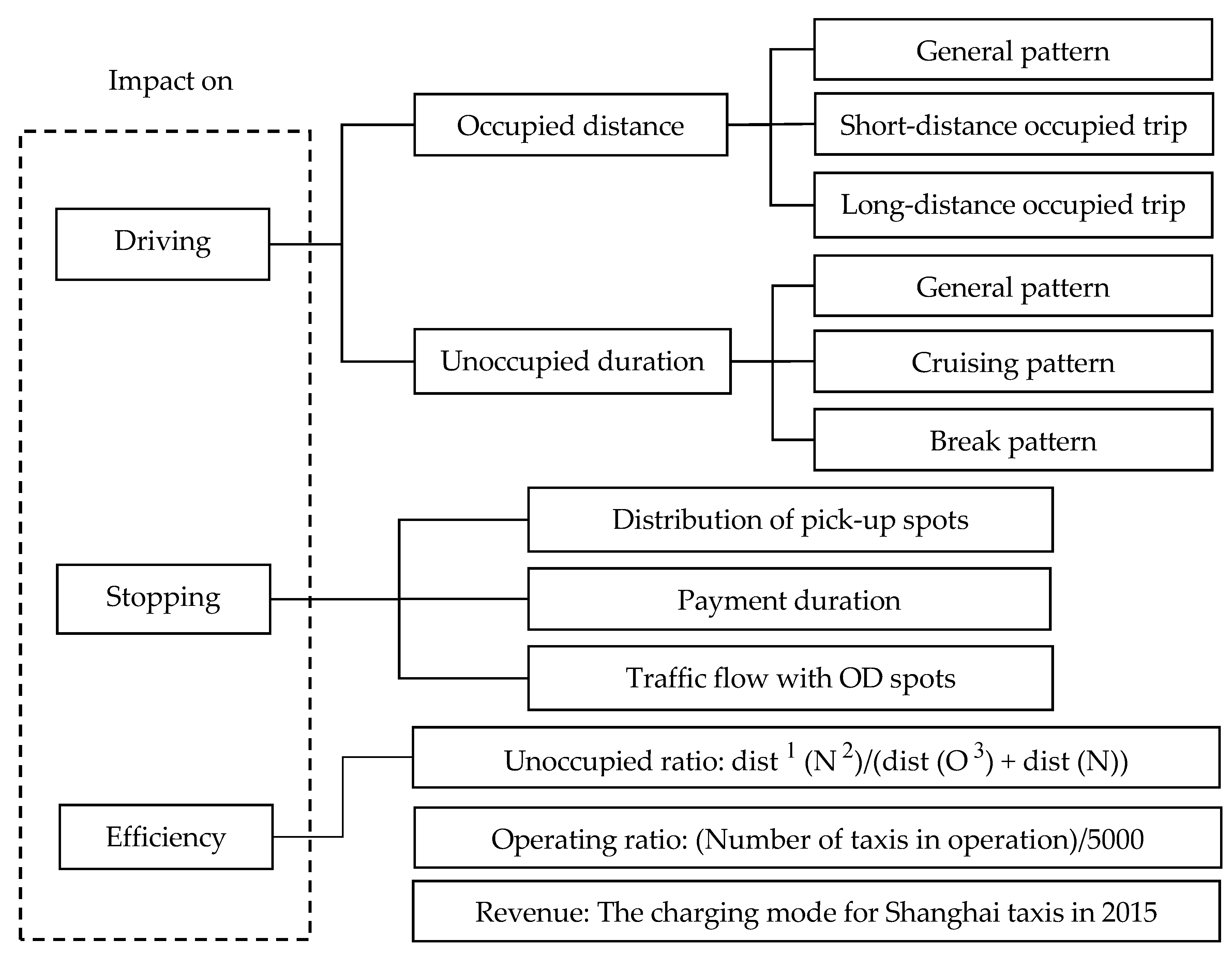


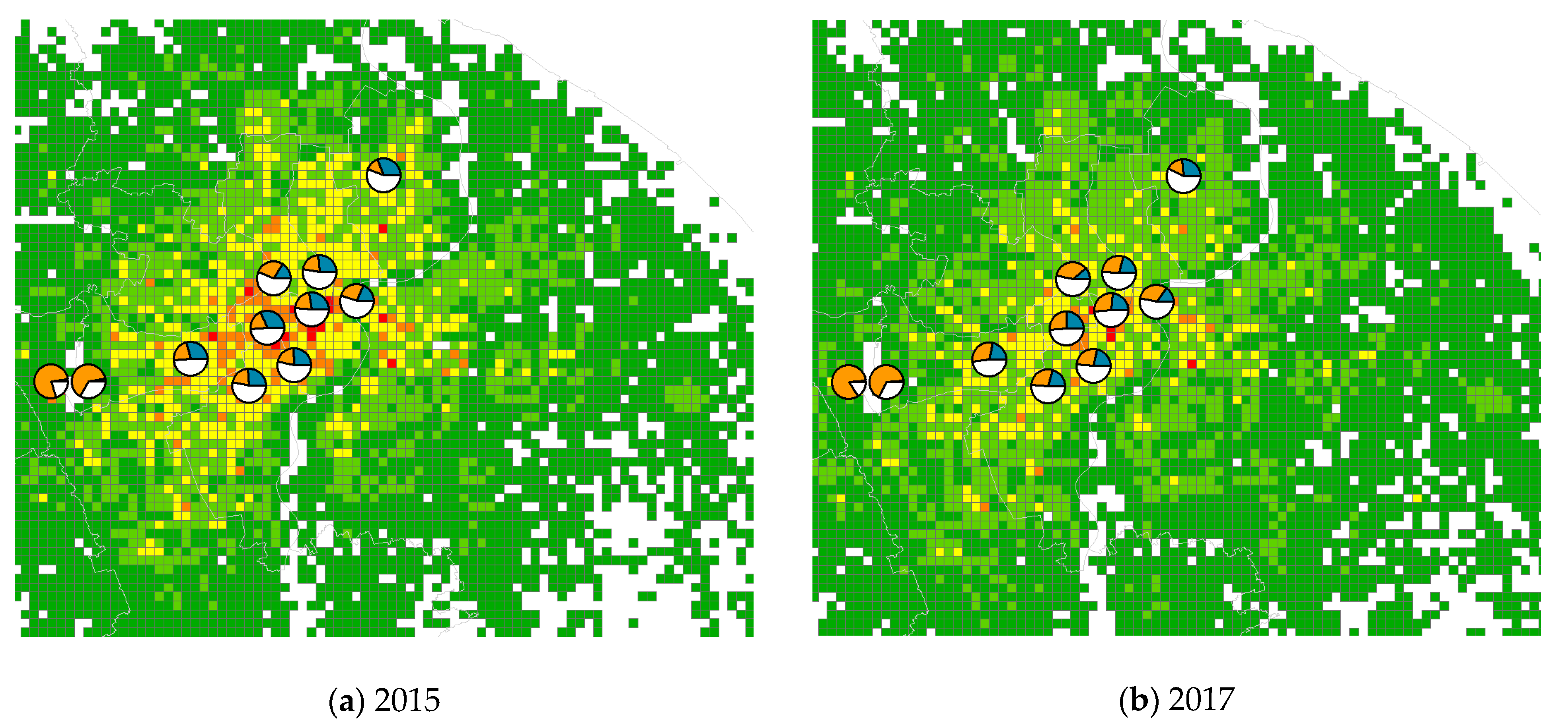

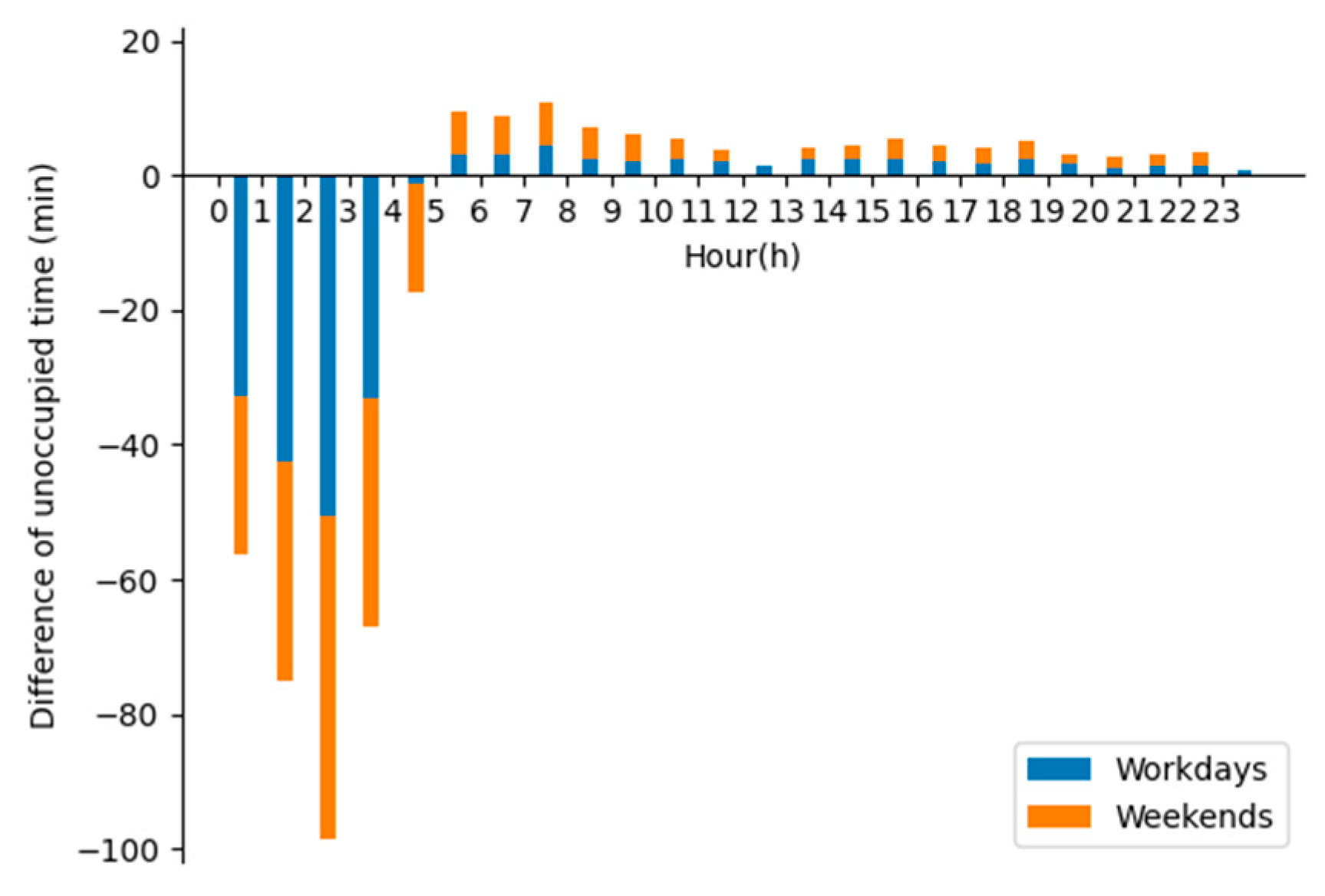
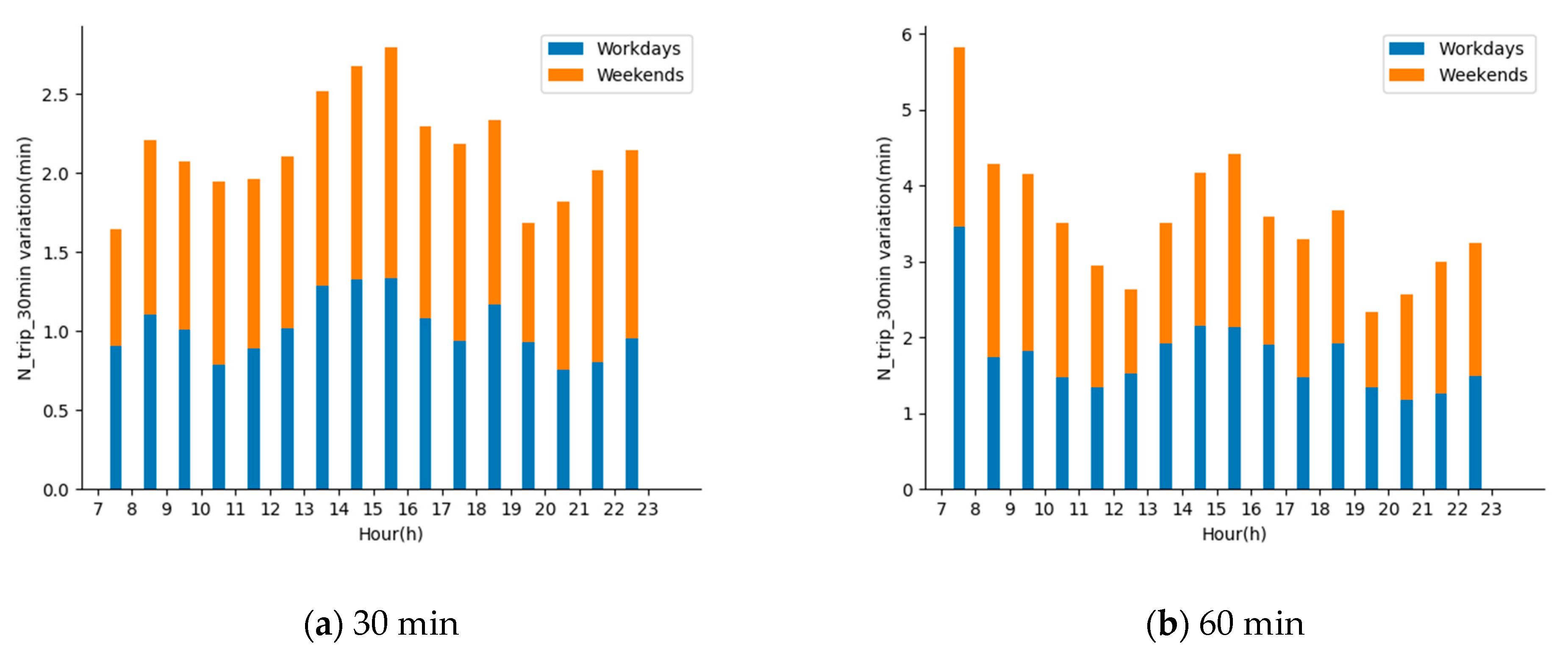
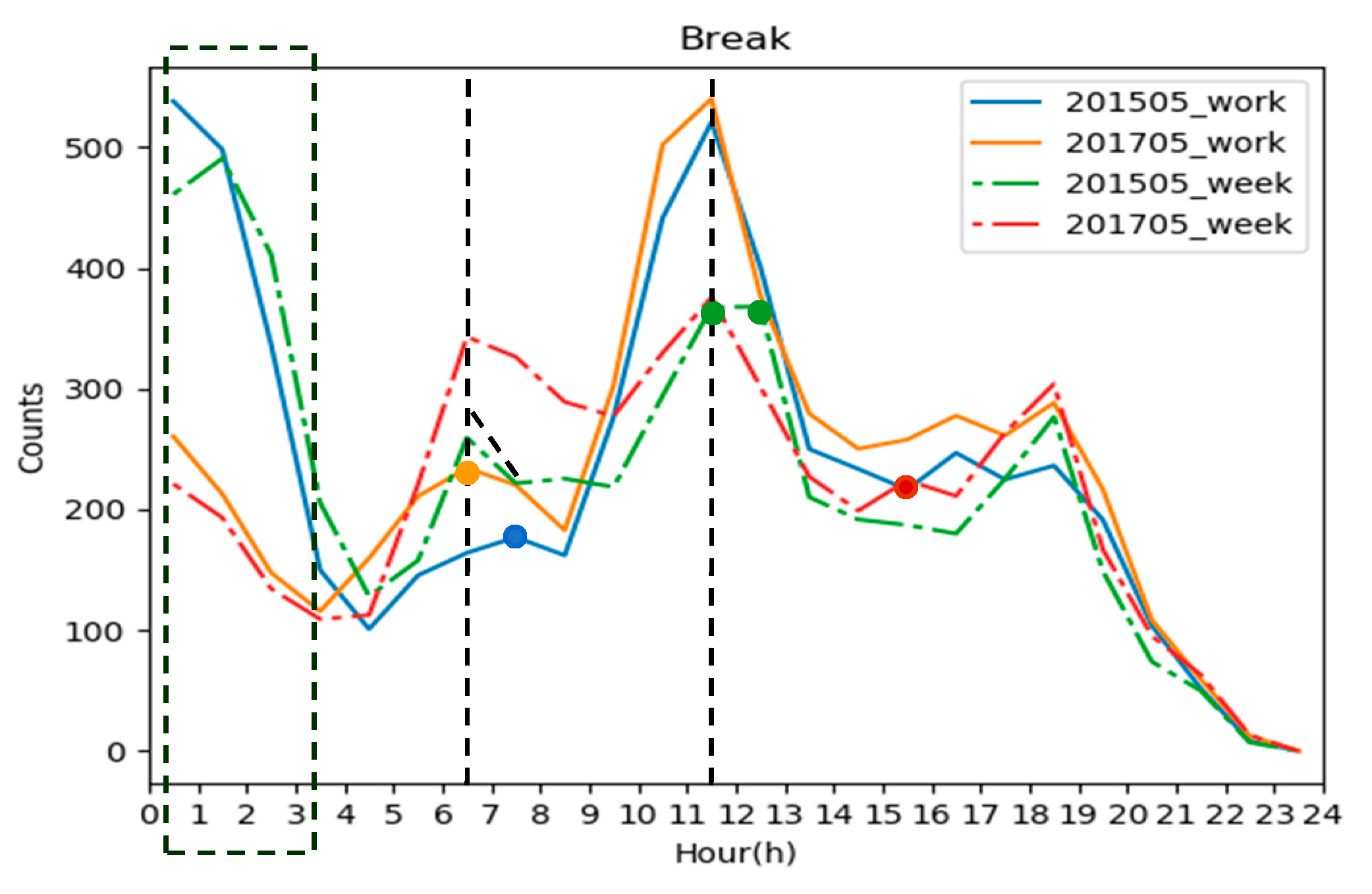

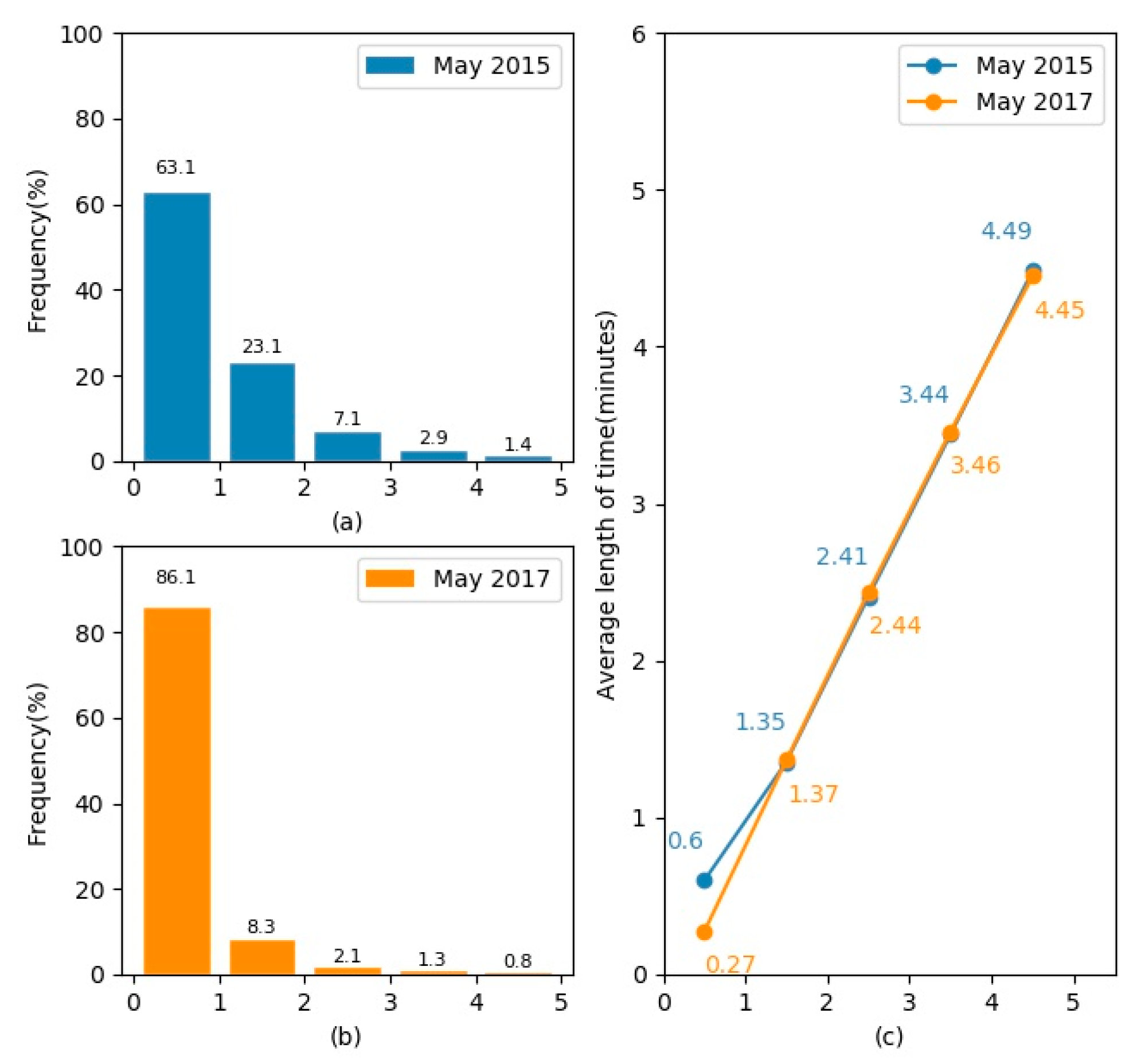
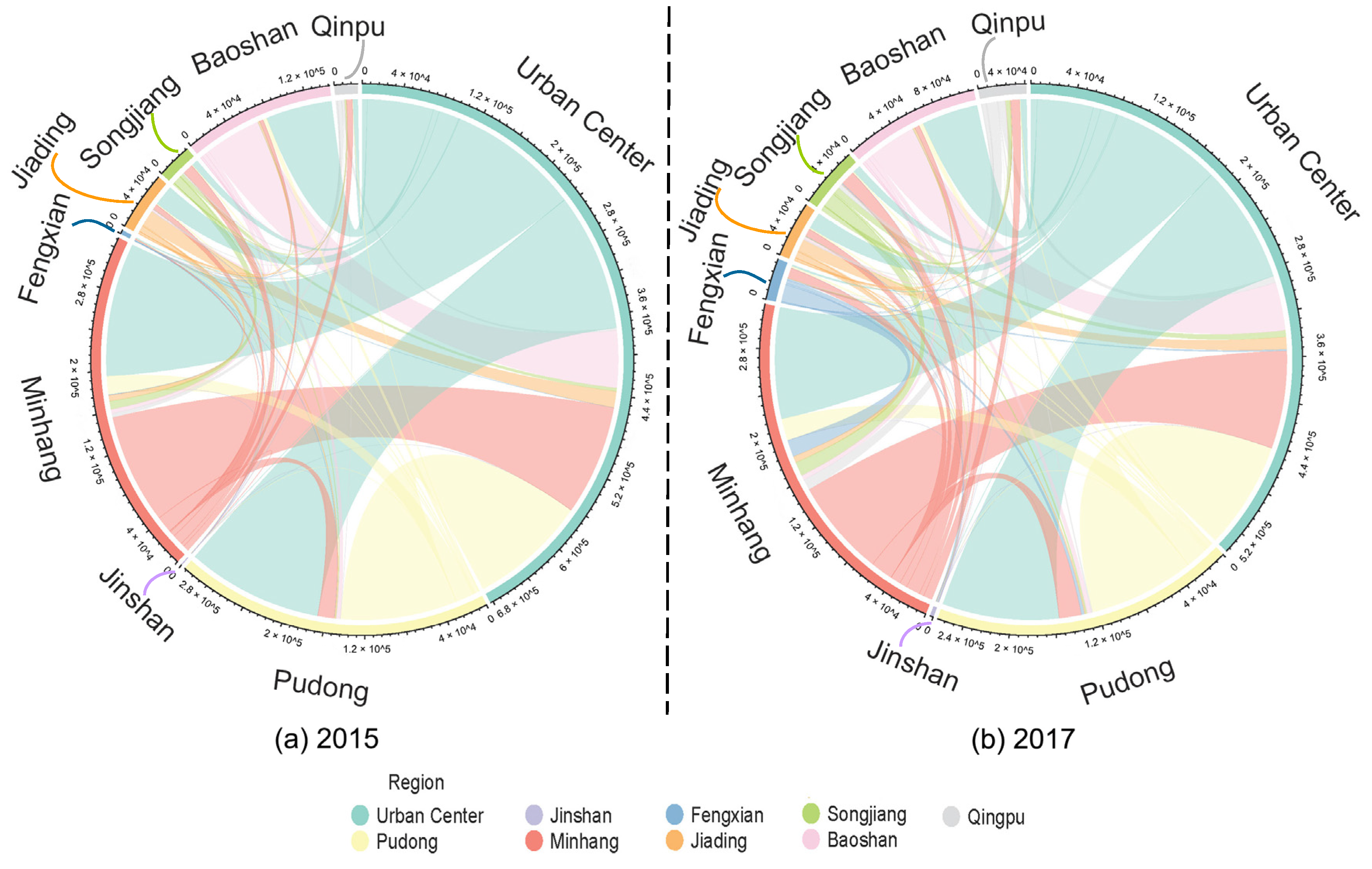
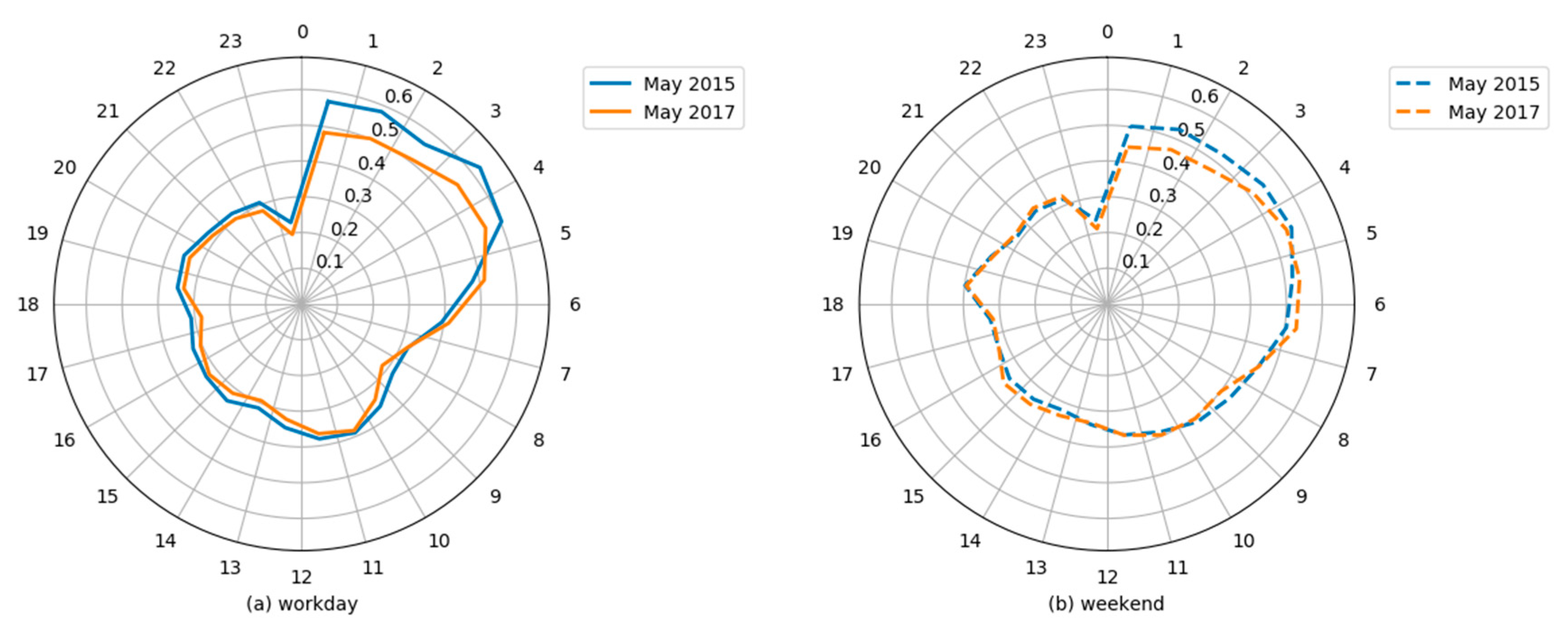
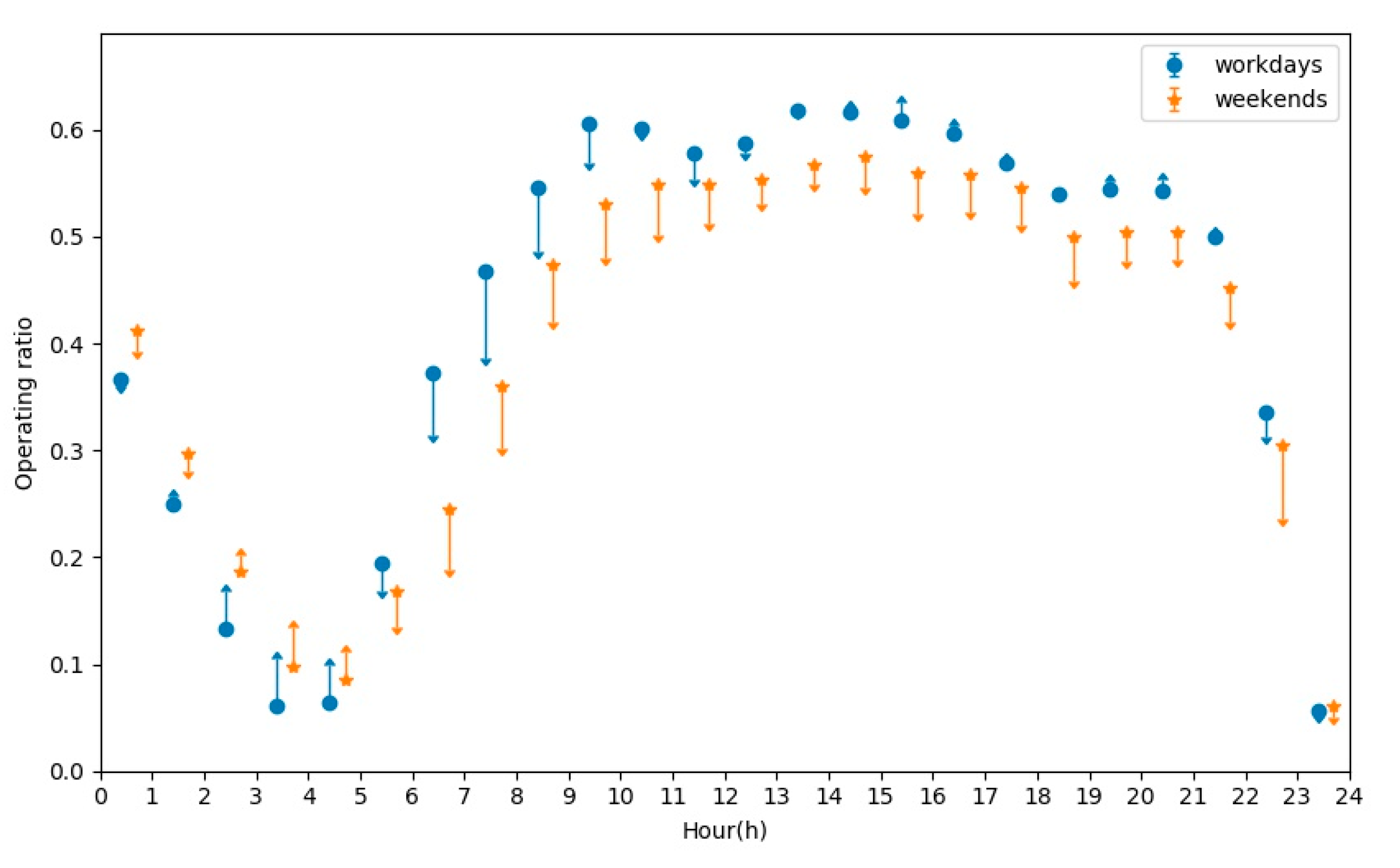
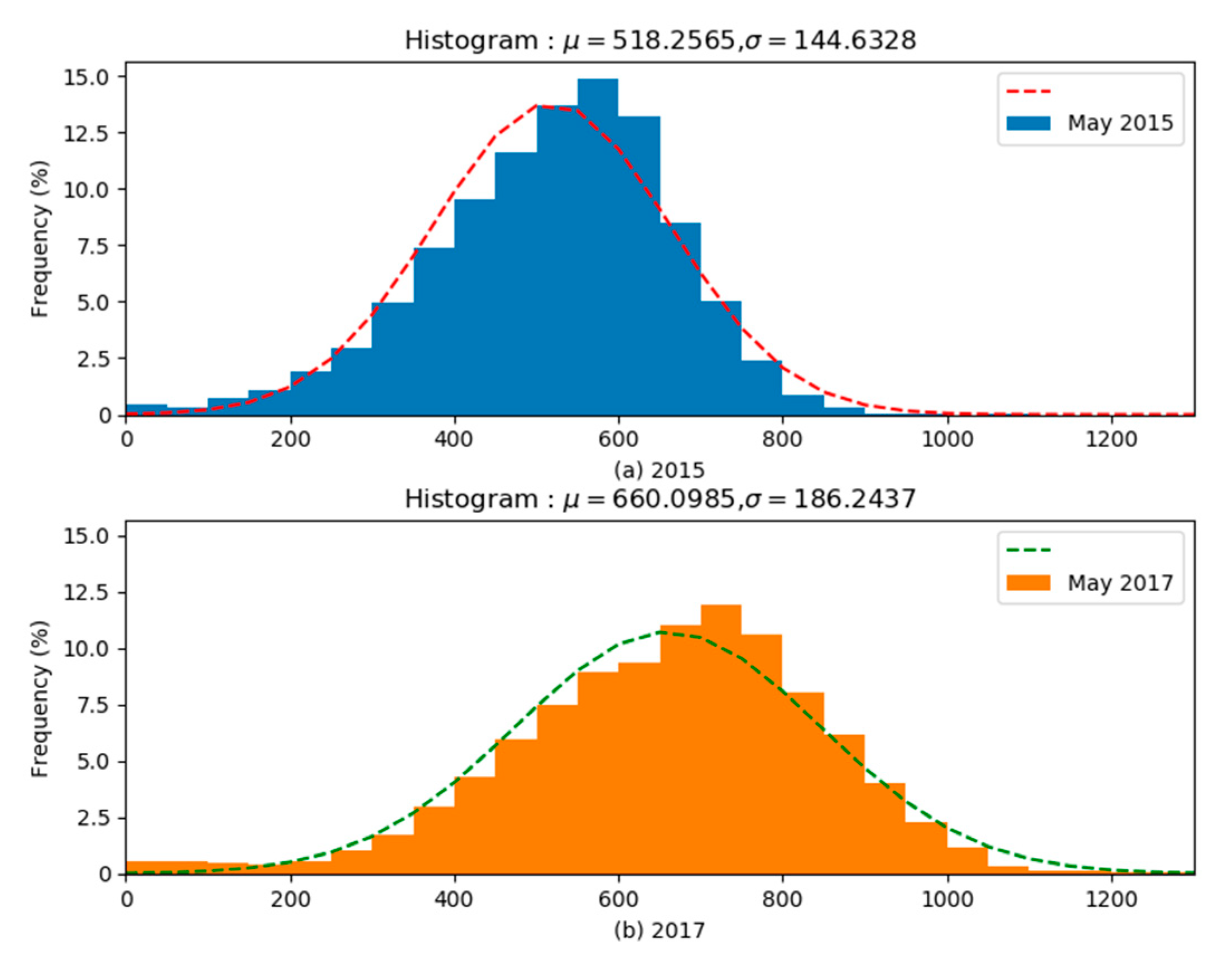
| Event | Property | Description |
|---|---|---|
| Trip events (vacant/occupied) | Date | Date the trip started, 8-digit number, yyyy-mm-dd |
| Time | Time the trip started, 6-digit number, hh-mm-ss | |
| GPSID | Car identifier, 5-digit number | |
| Trip_x | X coordinate of the origin of the trip, accurate to 6 decimal places, in degrees/units (meters) | |
| Trip_y | Y coordinate of the origin of the trip, accurate to 6 decimal places, in degrees/units (meters) | |
| Dis | The distance of the trip, accurate to 6 decimal places, in degrees/units (meters) | |
| Dur | The duration of the trip, units (seconds) | |
| Spot events (pick-up/drop-off) | Date | Date the trip started, 8-digit number, yyyy-mm-dd |
| Time | Time the trip started, 6-digit number, hh-mm-ss | |
| GPSID | Car identifier, 5-digit number | |
| X | X coordinate of the spot events, accurate to 6 decimal places, in degrees/units (meters) | |
| Y | Y coordinate of the spot events, accurate to 6 decimal places, in degrees/units (meters) | |
| Region | Administrative area number | |
| Pay_dur | The time interval between the drop-off point and the first moving point, units (seconds), only drop-off spot |
| Car Status | Velocity | Description |
|---|---|---|
| Load = 0 | V > 0 | C—Looking for the next customer while driving; |
| V = 0 | B—Suspension of business (e.g., lunch break or off duty) with a long break; | |
| S—Standing for passengers (airports, railway stations, shopping malls, hospitals, etc.). |
| Item | Daytime (05:00 a.m. to 11:00 p.m.) | Nighttime (11:00 p.m. to 05:00 a.m.) |
|---|---|---|
| F0 d 1∈(0, 3] km | 13 | 18 |
| F3 d∈(3, 10] km | 2.4 | 3.1 |
| F10 d∈(10, +∞) km | 3.6 | 4.7 |
Publisher’s Note: MDPI stays neutral with regard to jurisdictional claims in published maps and institutional affiliations. |
© 2021 by the authors. Licensee MDPI, Basel, Switzerland. This article is an open access article distributed under the terms and conditions of the Creative Commons Attribution (CC BY) license (http://creativecommons.org/licenses/by/4.0/).
Share and Cite
Gan, Y.; Fan, H.; Jiao, W.; Sun, M. Exploring the Influence of E-Hailing Applications on the Taxi Industry—From the Perspective of the Drivers. ISPRS Int. J. Geo-Inf. 2021, 10, 77. https://doi.org/10.3390/ijgi10020077
Gan Y, Fan H, Jiao W, Sun M. Exploring the Influence of E-Hailing Applications on the Taxi Industry—From the Perspective of the Drivers. ISPRS International Journal of Geo-Information. 2021; 10(2):77. https://doi.org/10.3390/ijgi10020077
Chicago/Turabian StyleGan, Yitong, Hongchao Fan, Wei Jiao, and Mengqi Sun. 2021. "Exploring the Influence of E-Hailing Applications on the Taxi Industry—From the Perspective of the Drivers" ISPRS International Journal of Geo-Information 10, no. 2: 77. https://doi.org/10.3390/ijgi10020077






